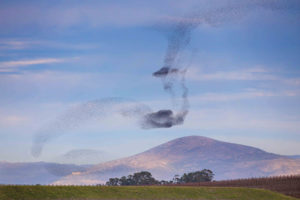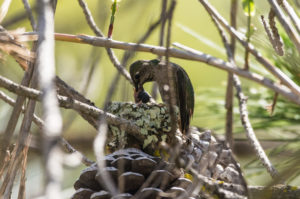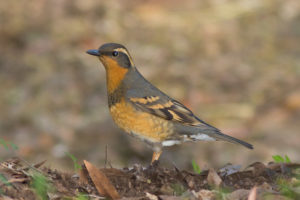
When you find a feather, what can it teach you? -Bob from San José
Well, the first thing you know is that it is from a bird! Currently, birds are the only creatures in existence that have feathers. But if you took a time machine back to the Jurassic and found a feather, it could be from a non-bird dinosaur. Fossils clearly show that some dinosaurs had feathers that they didn’t use for flying, long before some of them evolved into birds. A few of these feathers have been preserved in ancient amber.
So what were the first feathers for? Feathers could have evolved for insulation, solar protection, defense, communication, camouflage, or even a combination of all of these. Whatever the reason, most evolutionary biologists believe that feathers came first and feathered flight came later. After that infamous asteroid impact of 66 million years ago we said goodbye to dinosaurs, but ancestors of the 10,000 or so bird species in the world survived.
And Bob, if you find a huge pile of feathers on the ground you may deduce correctly that that bird has just been killed and eaten. Now you have a nice variety of feather types to choose from: contours, semiplumes, down feathers, filoplumes, and bristle feathers. For this question we’re going to stick with the contour feathers, the common feathers that cover a bird’s body and give it its shape and color. On the skin of that whole chicken you just bought for dinner, for example, are those so-called “goose bumps.” Each little pimple gives rise to one contour feather.
Feathers are made of keratin, like our nails and hair. They are fed with blood, and when they reach maturity they die and become inert, and the birds shed and regrow new feathers. If the feather you find is worn and tattered, it is an old one. If it is a new and still growing feather, it will have a papery sheath covering the calamus. I called an ornithologist friend who makes a career of netting and banding birds and he told me that a newly fledged bird will have looser and flimsier feathers. Some feathers may show stress bars: thin, translucent lines across the width of the feathers where they are weak. These can tell you that while the feather was growing the bird suffered from poor nutrition or disease or survived a predator attack.
It may also be possible to guess the sex. Males often have brightly colored feathers. Females tend to be drabber. Rarely, a feather may have a characteristic smell. When I volunteered years ago on the Farallon Islands we often found the ashy storm petrel nests deep in rocky burrows by smelling for the feathers. They have a very distinct, I must say pleasant, odor, emanating from stomach oils, which the birds use to preen and waterproof their feathers.
I like guessing a feather’s original position on the bird. The primary flight feathers are those 10 or so located on the wing that propel the bird through the air. They are long (most of them), strong, and concave. You may be able to even tell the approximate position. Toward the front, the anterior vane is quite narrow and as you move back along those 10 flight feathers the posterior vane becomes smaller and smaller relative to the anterior vane.
A large feather could also be a tail feather. Most birds have 12 tail feathers and again, you can tell the approximate position based on the relationship of the vanes to one another. Brown creepers and woodpeckers have very stiff tail feathers. They use them almost as a third leg to prop up against the tree trunks. My favorite tail feathers come from red-shafted flickers, which have long been used by Native Californians to make baskets and headdresses.
For a species ID, A Guide to North American Species: Bird Feathers by S. David Scott and Casey McFarland can help a hard-core pulmologist. Or you might try the U.S. Fish and Wildlife Service’s online “Feather Atlas.”
But remember that picking up stray feathers and keeping them is generally illegal without a permit, according to the Migratory Bird Treaty Act.




